Offshore Wind 101
The strong wind resource off the U.S. Atlantic coast has tremendous renewable energy generation potential. New York State is working to responsibly and cost-effectively develop renewable energy sources to provide 70% of the State’s electrical power by 2030. Offshore wind is poised to become a major asset in the State’s transition away from harmful fossil fuels towards a 100% carbon-free energy future by 2040.
How Big Are Offshore Wind Turbines?
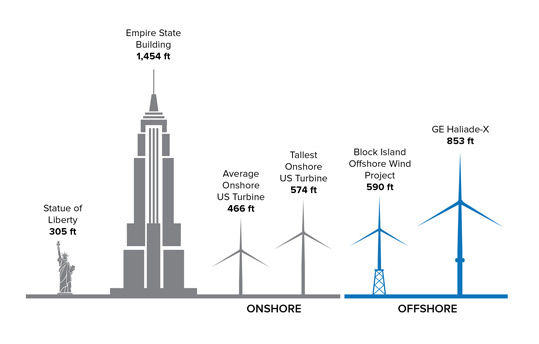

Height comparisons:
- Statue of Liberty: 305 ft.
- Empire State Building: 1,454 ft.
- Average Onshore U.S. Turbine: 466 ft.
- Tallest Onshore U.S. Turbine: 574 ft.
- Block Island Offshore Wind Project: 590 ft.
- GE Haliade-X Offshore Turbine: 853 ft.
View more about height comparisons View more about height comparisons
How It Works
Offshore wind turbines work to harness the ocean’s vast wind and convert it into 100% renewable electricity.
Overview of Power Generation
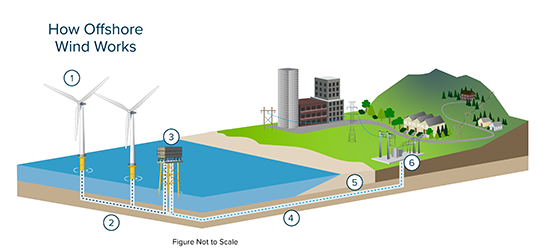

- Offshore Turbines capture the wind's energy and generate electricity.
- Foundations secure turbines to the ocean floor and cables transmit electricity to an offshore substation.
- Electricity flows through a buried cable to an onshore substation and is transferred to the existing transmission network.
Turbine Components
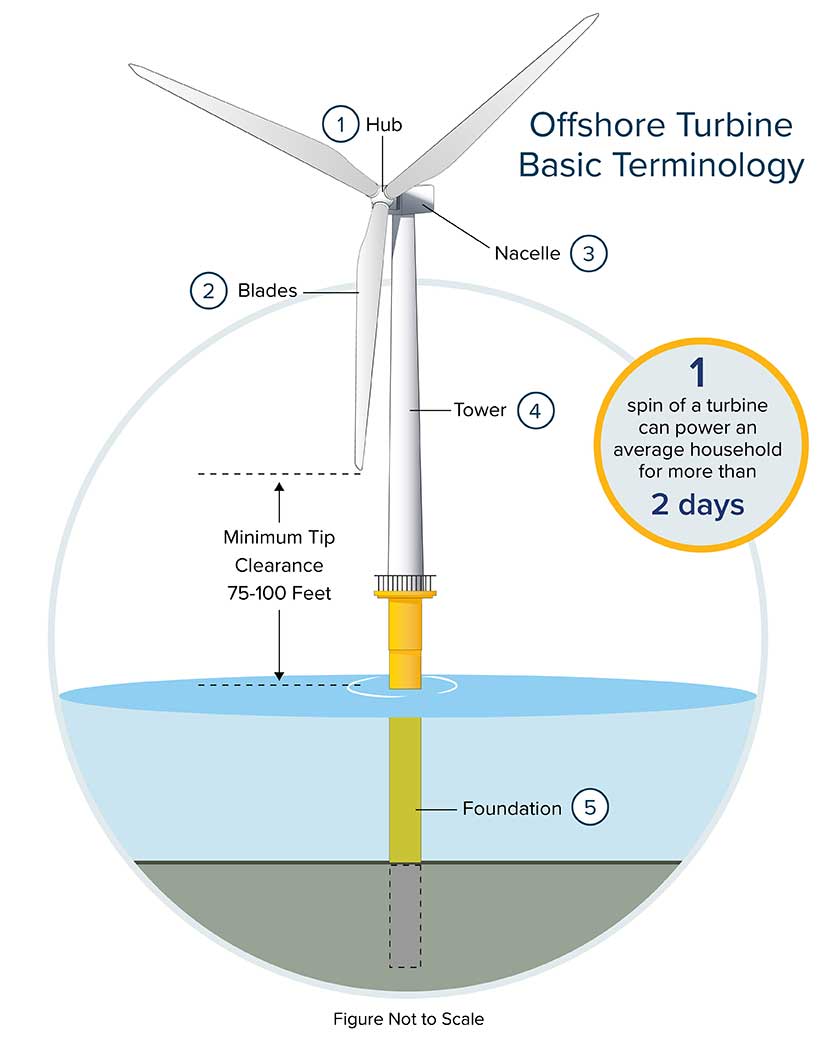

- Hub. The hub supports the blades and houses the pitch system, which optimizes blade angle and rotation speed.
- Blades. Blades capture the wind's energy and convert it into mechanical energy.
- Nacelle. The nacelle houses the components that convert mechanical energy to electrical energy.
- Tower. The tower supports the mass of the nacelle, hub, and blades.
View more about turbine components View more about turbine components
Foundations, Array Cables, and Offshore Substation
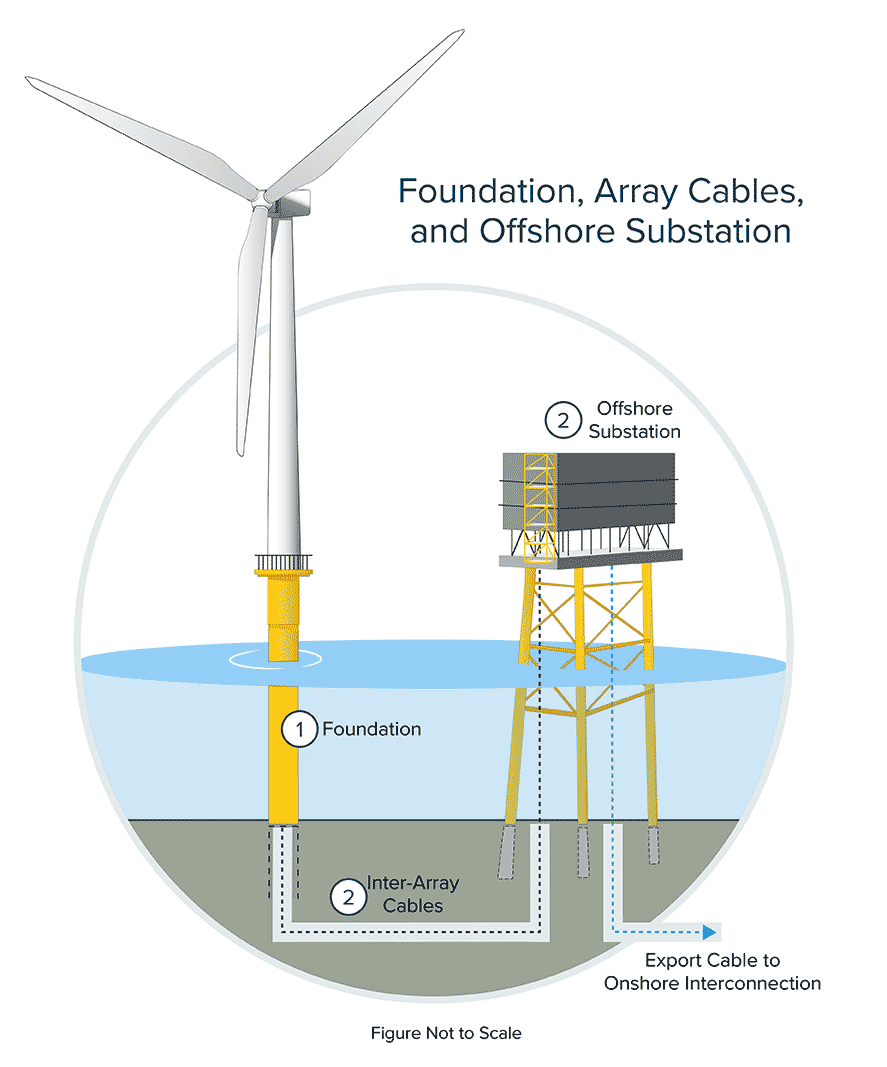

- Foundation. Foundations secure the tower and above-water turbine components to the sea floor. A variety of technologies are available, including jackets, monopiles, and gravity-based foundations.
- Array Cables. A network of array cables link the wind turbines together and deliver power from the turbines to the offshore substation.
- Offshore Substation. The offshore substation collects and stabilizes the power generated by the turbines, preparing it for transmission to shore.
Export Cable and Onshore Connection
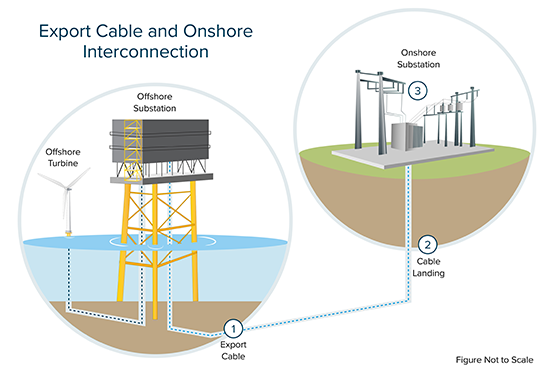

- Export Cable. The export cable is buried deep enough to avoid disturbing ocean users and wildlife, and it transmits power from the offshore substation to the onshore substation.
- Cable Landing. Horizontal direction drilling, a common method for landing export transmission cables from offshore wind farms, minimizes environmental impacts and disruption to beaches and the shoreline.
- Onshore Connection. Electricity is transferred to the existing transmission network.
The Role of Government
Offshore wind development in the U.S. is overseen by both federal and state agencies. Local governments may also be involved for local land-use approvals.
The Federal Role
The federal government has jurisdiction over all ocean activities more than three nautical miles from the shore. Specifically, the Bureau of Ocean Energy Management (BOEM) is responsible for selecting areas of the ocean that are appropriate for wind energy development, leasing the wind energy areas (WEAs) to project developers, and reviewing and approving all aspects of plans to design, develop, and decommission offshore wind farms in federal waters as part of the National Environmental Policy Act (NEPA).
- Learn more about Siting Offshore Wind
- Learn more about BOEM’s Regulatory Framework and Guidelines

Other Involved Agencies
- Environmental Protection Agency

- Federal Aviation Administration

- National Oceanic and Atmospheric Administration

- U.S. Army Corps of Engineers

- U.S. Coast Guard
- U.S. Fish and Wildlife Service

The State Role
Through competitive solicitations, NYSERDA contracts with offshore wind developers who want to deliver power to New York State. Specifically, NYSERDA purchases offshore renewable energy certificates (ORECs) from the developers in order to account for the beneficial environmental attributes associated with generating clean power. Contracts with offshore wind developers include important provisions that dictate how New York State will benefit from the project, such as economic benefit commitments and environmental and fishing mitigation plans.
The Local Role
Renewable energy from offshore wind farms connects to New York’s existing electricity grid at onshore substations. When determining an optimal route from the shore to a local substation, project developers consult with relevant local governments and may enter into easement agreements if the route transacts government-owned roads or property.
